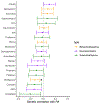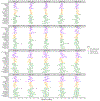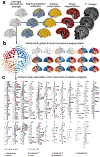Shared heritability of human face and brain shape
- PMID: 33821002
- PMCID: PMC8232039
- DOI: 10.1038/s41588-021-00827-w
Shared heritability of human face and brain shape
Abstract
Evidence from model organisms and clinical genetics suggests coordination between the developing brain and face, but the role of this link in common genetic variation remains unknown. We performed a multivariate genome-wide association study of cortical surface morphology in 19,644 individuals of European ancestry, identifying 472 genomic loci influencing brain shape, of which 76 are also linked to face shape. Shared loci include transcription factors involved in craniofacial development, as well as members of signaling pathways implicated in brain-face cross-talk. Brain shape heritability is equivalently enriched near regulatory regions active in either forebrain organoids or facial progenitors. However, we do not detect significant overlap between shared brain-face genome-wide association study signals and variants affecting behavioral-cognitive traits. These results suggest that early in embryogenesis, the face and brain mutually shape each other through both structural effects and paracrine signaling, but this interplay may not impact later brain development associated with cognitive function.
Conflict of interest statement
Competing interests statement
The authors declare no competing interests.
Figures














Comment in
-
Our faces and brains.Nat Genet. 2021 Jun;53(6):765-766. doi: 10.1038/s41588-021-00858-3. Nat Genet. 2021. PMID: 33888909 No abstract available.
Similar articles
-
Genome scans of facial features in East Africans and cross-population comparisons reveal novel associations.PLoS Genet. 2021 Aug 19;17(8):e1009695. doi: 10.1371/journal.pgen.1009695. eCollection 2021 Aug. PLoS Genet. 2021. PMID: 34411106 Free PMC article.
-
Novel genetic loci affecting facial shape variation in humans.Elife. 2019 Nov 26;8:e49898. doi: 10.7554/eLife.49898. Elife. 2019. PMID: 31763980 Free PMC article.
-
A genome-wide association study identifies five loci influencing facial morphology in Europeans.PLoS Genet. 2012 Sep;8(9):e1002932. doi: 10.1371/journal.pgen.1002932. Epub 2012 Sep 13. PLoS Genet. 2012. PMID: 23028347 Free PMC article.
-
Joint multi-ancestry and admixed GWAS reveals the complex genetics behind human cranial vault shape.Nat Commun. 2023 Nov 16;14(1):7436. doi: 10.1038/s41467-023-43237-8. Nat Commun. 2023. PMID: 37973980 Free PMC article. Review.
-
Genetic architecture of brain morphology and overlap with neuropsychiatric traits.Trends Genet. 2024 Aug;40(8):706-717. doi: 10.1016/j.tig.2024.04.005. Epub 2024 May 2. Trends Genet. 2024. PMID: 38702264 Review.
Cited by
-
GRHL2 and AP2a coordinate early surface ectoderm lineage commitment during development.iScience. 2023 Feb 3;26(3):106125. doi: 10.1016/j.isci.2023.106125. eCollection 2023 Mar 17. iScience. 2023. PMID: 36843855 Free PMC article.
-
Microvascular and macrovascular complications of type 2 diabetes mellitus: Exome wide association analyses.Front Endocrinol (Lausanne). 2023 Mar 23;14:1143067. doi: 10.3389/fendo.2023.1143067. eCollection 2023. Front Endocrinol (Lausanne). 2023. PMID: 37033211 Free PMC article.
-
Novel early-onset Alzheimer-associated genes influence risk through dysregulation of glutamate, immune activation, and intracell signaling pathways.Res Sq [Preprint]. 2024 Jun 5:rs.3.rs-4480585. doi: 10.21203/rs.3.rs-4480585/v1. Res Sq. 2024. Update in: Alzheimers Dement. 2025 Jun;21(6):e70377. doi: 10.1002/alz.70377. PMID: 38883718 Free PMC article. Updated. Preprint.
-
Identification and validation of supervariants reveal novel loci associated with human white matter microstructure.Genome Res. 2024 Feb 7;34(1):20-33. doi: 10.1101/gr.277905.123. Genome Res. 2024. PMID: 38190638 Free PMC article.
-
MicroRNA-eQTLs in the developing human neocortex link miR-4707-3p expression to brain size.Elife. 2023 Jan 11;12:e79488. doi: 10.7554/eLife.79488. Elife. 2023. PMID: 36629315 Free PMC article.
References
MAIN REFERENCES
METHODS REFERENCES
Publication types
MeSH terms
Grants and funding
- U24 DA041147/DA/NIDA NIH HHS/United States
- U01 DA041120/DA/NIDA NIH HHS/United States
- U01 HG009431/HG/NHGRI NIH HHS/United States
- R01 DE027023/DE/NIDCR NIH HHS/United States
- R01 HG008140/HG/NHGRI NIH HHS/United States
- U01 DA041093/DA/NIDA NIH HHS/United States
- HHSN268201200008C/HL/NHLBI NIH HHS/United States
- U01 DA041156/DA/NIDA NIH HHS/United States
- R01 DE016148/DE/NIDCR NIH HHS/United States
- U01 DA041089/DA/NIDA NIH HHS/United States
- U01 DA041106/DA/NIDA NIH HHS/United States
- U01 DA041148/DA/NIDA NIH HHS/United States
- K22 HG000044/HG/NHGRI NIH HHS/United States
- HHSN268201200008I/HL/NHLBI NIH HHS/United States
- U01 DA041174/DA/NIDA NIH HHS/United States
- U24 DA041123/DA/NIDA NIH HHS/United States
- U01 DE020078/DE/NIDCR NIH HHS/United States
- U01 DA041134/DA/NIDA NIH HHS/United States
- U01 DA041022/DA/NIDA NIH HHS/United States
- U01 DA041025/DA/NIDA NIH HHS/United States
- HHMI/Howard Hughes Medical Institute/United States
- T32 HG000044/HG/NHGRI NIH HHS/United States
- U01 DA041117/DA/NIDA NIH HHS/United States
- R01 DA033431/DA/NIDA NIH HHS/United States
- U01 DA041028/DA/NIDA NIH HHS/United States
- U01 DA041048/DA/NIDA NIH HHS/United States
LinkOut - more resources
Full Text Sources
Other Literature Sources

